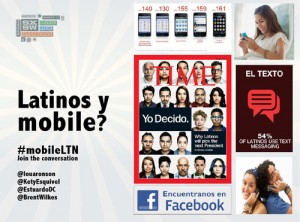Latinos y Mobile: A Silver Bullet?
Austin Convention Center, Room 5ABC
Friday, March 8, 5:00PM – 6:00PM
 It’s hard to imagine life before smartphones, but barely seven years ago, the iPhone was only a twinkle in Steve Jobs’s eye. Today, over half of U.S. mobile phone users utilize smartphones. Without a doubt, the future of the Internet will be on mobile devices.
It’s hard to imagine life before smartphones, but barely seven years ago, the iPhone was only a twinkle in Steve Jobs’s eye. Today, over half of U.S. mobile phone users utilize smartphones. Without a doubt, the future of the Internet will be on mobile devices.
Also shaping the future of the Internet, are Latinos, the fastest growing demographic in the United States. According to the Pew Internet & American Life Project, Hispanics lead in smartphone ownership and mobile Internet consumption. “What’s most unique about the Latino population, in terms of mobile, is the amount of penetration that has taken place” explains Lou Aronson, CEO & Founder of Discourse Analytics, Inc and VOTIFI, a semi-finalist at the 2012 SXSWi Accelerator competition.

Aronson, along with experts from across the private sector and Latino community, will look toward and discuss this future at the “Latinos y Mobile: A Silver Bullet?” panel at the 2013 South By Southwest Interactive conference. The “Latinos y Mobile” panel aims to be more than just the run-of-the-mill mobile communications presentation. Rather, Aronson explains, the speakers plan to examine “how a diverse community with a growing technology can evolve to embrace, adopt, utilize it.”
The growth of mobile in the Latino market can be largely attributed to market forces. With “the cost of owning smartphones coming down and the functionality going up, you see a fundamental shift in how this technology can get into the hands of people on a fairly low cost basis,” explains Aronson. For example, when Cricket Mobile, a low-cost mobile carrier, made smartphones available on a prepaid basis, major carriers followed suit, including AT&T and Verizon.
The rapid proliferation of smartphones in this untapped market seems to represent the waning of the digital divide, or the inequality in access to information and communication technology. However, Aronson posits that the digital divide is now more than simply connecting to the web, but rather the ability to engage with and influence mass media. “You have people with access to this technology, then you see a flurry of activity that can become, if used properly, very powerful,” explains Aronson.
The power of this activity manifests most obviously in social media engagement. A study by the Pew Internet and American Life Project found that 18 percent of Hispanics online are Twitter users, in sharp contrast with only 5 percent of non-Hispanic whites. Latino engagement on Twitter is not an aberration; other social media channels reflect strong representation of Latino users.
The combination of mobile Internet use and Latino social media engagement creates an unprecedented opportunity to engage with an audience. “The folks on the other side of the black box are communicating with us,” says Aronson, and if brands intend to stay relevant, they must learn to listen.
Aronson points to failed campaigns in marketing to Latinos as the most compelling reason organizations need to tune into what Latinos are saying. Attempted outreach to Latinos during the 2012 Presidential Election is among the worst offenders according to Aronson, “why should every conversation be about immigration and Spanish?” Post-election analysis of the election considers the GOP’s failure to connect with Latinos as a contributing factor to Romney’s failed bid to win the White House. “If you’re not opening up that feedback loop and listening,” he continues, “then you’re missing a really valuable opportunity.”
Aronson hopes to contribute to the growing research documenting the Latino community’s relationship with technology and you can help. Take the LatinoVoice Survey, which will be used to help make the Hispanic voice heard at the 2013 South By Southwest Interactive conference.
Click here to launch the survey.
